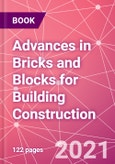The book reviews the current state of bricks and blocks; their manufacture, properties and applications in the building construction sector.
About the Author
Dr. Mohammad Arif Kamal is an architect, having around 16 years of Teaching, Research and Professional experience in the field of Architecture, Building Construction Technology and Interior Design. He studied architecture at Aligarh Muslim University, Aligarh from where he received his Bachelor of Architecture (B. Arch.) degree with honors. He was awarded a Government of India, Ministry of Human Resource Development (MHRD) fellowship for pursuing both Master of Architecture (M. Arch.) and Ph.D. degree in Architecture from Indian Institute of Technology (IIT), Roorkee, India. He has designed and implemented many architecture and interior design projects besides his teaching duties both on Design Theory, Construction Systems, Sustainable Architecture, Interior Design as well as Architectural Design Studios.
Dr. Kamal is presently working as an Associate Professor in Aligarh Muslim University, India. He has also worked as Assistant Professor in the Dept. of Architecture at KFUPM, Saudi Arabia for 3 years. He was awarded Junior Faculty Development Grant at KFUPM, Saudi Arabia in 2010. He was associated with an International Architectural Project ‘The Mataaf Design Intervention in Haram Mosque’, Mecca, Saudi Arabia. His area of research includes Environmental Design, Climate Responsive Architecture, Sustainable Architecture, Building Construction Systems, Building Materials and Traditional Architecture. He has published many Research papers in various International Journals and Conferences as well as many articles in Building Construction Magazines. He has published 3 books and 10 book chapters. He is Editor-in-Chief of 7 International journals related to Architecture, Construction and Civil Engineering. He has edited 5 Special Topic Volume Related to Sustainable Building Materials, published by Trans Tech Publications, Switzerland. He is member of editorial board team/ associate editors of many International journals and conferences and also member of many national and International associations / professional bodies.








